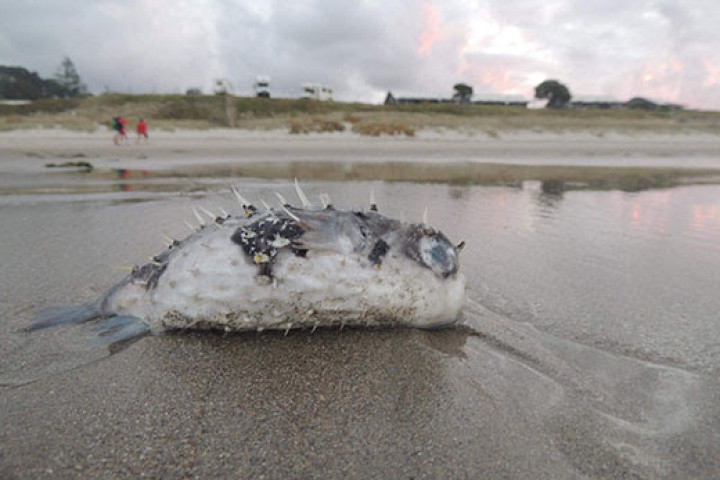Beachgoers warned not to touch puffer fish
Beachgoers warned not to touch puffer
fish

Dog owners are
being warned about taking their pets on Whangamata and
Whitianga beaches after a number of dead pufferfish were
found washed up today.
"We advise people and pets to keep a safe distance and not touch the fish as they could potentially have a neurotoxin in their skin and intestine and they have sharp spines," says Brian Taylor our Compliance and Licencing Manager.
Our Environmental Health team have found a number of the fish at Whangamata and Whitianga beaches, which they have since removed and taken for testing.
"As it will be several weeks until we get results on whether these pufferfish are poisonous, we are putting out a precautionary message to the public now to play it safe," says Mr Taylor.
"As we have seen these fish wash up at two different beaches, there could also be good reason to suspect they are washing up along the entire east coast of the Coromandel including Tairua, Pauanui, Hahei and Hot Water Beaches," says Mr Taylor.
Last month hundreds of dead birds and 38 puffer fish were found at Mount Maunganui. You can read more about that incident here.
Pufferfish facts:
• The pufferfish toxin is called Tetrodotoxin (TTX)
• Related to poisonous Japanese fugu puffer fish
• Their spines are sharp
• The liver and other parts of the fish are very toxic
• Do not touch them
• Do not let your dogs near them.
Sea slugs
There have been media reports of dog deaths anecdotally linked to a species of sea slug on the Thames Coast which can be toxic; however, at this stage there has been no evidence provided to our Council.
Initial investigations by Council staff have failed to find sea slugs.
Children and pets need to be supervised on beaches and parents need to be aware of where children are swimming or playing and what they are handling.
The sea slugs are a translucent grey colour and are up to 10cm in length. If present, the sea slugs can be found at low tide. The NIWA fact sheet on the sea slugs says a human would need to eat 2.6g of sea slug in order to ingest a lethal dose of the toxin. That's about half a teaspoon of sea slug.
If you spot a sea slug, leave it alone, mark the spot and call us on 07 868 0200 and ask to speak to an Environmental Health Officer to report its location.
More info can be found on the NIWA fact sheet here.
ends


 Gordon Campbell: On Free Speech And Anti-Semitism
Gordon Campbell: On Free Speech And Anti-Semitism LIANZA: Library Association Congratulate Christchurch City Council For Recognising Pay Equity For Library Workers
LIANZA: Library Association Congratulate Christchurch City Council For Recognising Pay Equity For Library Workers Quality Public Education Coalition - QPEC: Understanding School Absence - David Seymour Warns Of Prosecutions This Year In School Truancy Crackdown
Quality Public Education Coalition - QPEC: Understanding School Absence - David Seymour Warns Of Prosecutions This Year In School Truancy Crackdown PSA: Sunday Rally To Protest Outrageous Suspension Of 38 Disability Workers
PSA: Sunday Rally To Protest Outrageous Suspension Of 38 Disability Workers NZDF: 1st NZSAS Regiment Marks 70th Anniversary
NZDF: 1st NZSAS Regiment Marks 70th Anniversary Choose Clean Water: Changes To Fish & Game Continue Coalition’s Handover Of Power To Polluters
Choose Clean Water: Changes To Fish & Game Continue Coalition’s Handover Of Power To Polluters Inland Revenue Department: Tax Assessment Period A Prime Time For Scams, Expert Warns
Inland Revenue Department: Tax Assessment Period A Prime Time For Scams, Expert Warns


